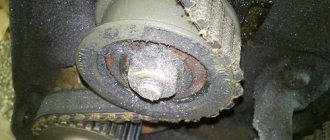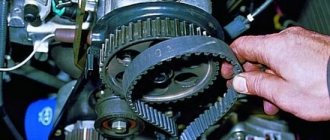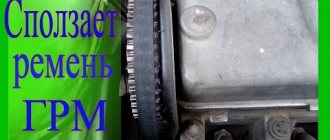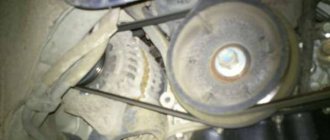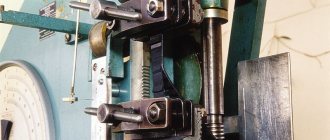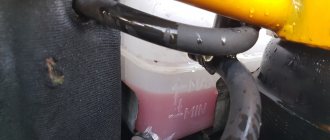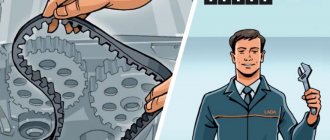Why does the belt break?
1) Everything is banal and simple. The timing belt is a fairly strong “link” on foreign cars; it can last quite a long time, about 150,000 kilometers. However, everything has a limit! Over such a period of time it simply “wears out”, it becomes thinner and is no longer able to hold tension - that’s why it breaks. This is the most common reason - they simply did not replace it on time. It should be noted that on our VAZs, the belt runs much less, for example, from 30 to 50,000 kilometers. Personally, I had cases when it broke after 15,000 km. That is why the main complaints come from the owners of PRIOR, Kalin and other AvtoVAZ. If you bought our car, and even second-hand, then I advise you to replace the belt immediately! Otherwise there may be problems.
2) Another reason is the failure of the tension rollers. They are designed to tension the belt so that it does not slip or fly off the teeth. Essentially, rollers are bearings with a special layer on top, and as you and I know, bearings also have a service life. Towards the end of operation they begin to make noise and your engine begins to “diesel”. If you don’t change them, they will simply jam, which will literally erase the timing belt “canvas” in just hours.
3) Sometimes a break does not occur, but due to excessive wear, the rubber teeth that mesh with the shaft gears break. It’s also not very pleasant, you look - there is no break - but the car does not start, or it starts, but does not work correctly! The fact is that the ignition is faulty and needs replacement again.
4) On our cars, sometimes the pump jams. It can also wipe the timing belt, see the video below.
5) Well, the last reason is poor quality spare parts. This often happens, again with our VAZs. For example, you came to a service station, replaced the consumables, drove 5000 km, and it “BANG” and broke off. A “burnt part” is death for the engine, no matter what it is. So try to buy such components from trusted service stations, even if from an official dealer, they don’t skimp on the timing belt.
In general, there was an impulse, what next...
What will happen, what consequences await?
You know, sometimes you can get away with it, that is, without suffering any damage. Just install the new one, set up the car and that’s it – let’s move on! But sometimes you end up with very expensive repairs.
When the timing belt breaks, it is mainly the valves that suffer - if we “exaggerate the picture”, it turns out that the upper camshaft does not work due to a break, the valves are frozen in one position, but the crankshaft pushes the piston up - this is where the piston and valve meet , and the weak link suffers - very often the valve bends.
Less often, but again it happens - the camshaft pastel breaks, or the upper part of the piston breaks.
This is a very unfavorable situation, at a minimum you need to change the valves, which means disassembling the engine - buying a new gasket, lapping the valves correctly, etc. ON some foreign cars, repairs reach 30,000 rubles. But if the pastel and pistons are damaged, then it’s even more expensive.
“But wait,” you say, but what about “getting away with it”?
Yes, this also happens - many manufacturers make special recesses in the upper part of the piston. The bottom line is this: when a break occurs, the piston goes up - the valve is in place - but when the piston reaches the top point, it falls into the hole and no “jam” occurs. You just need to put on a new belt, set the marks and start the engine. ALL!
“Just wonderful,” you say. But why shouldn’t all manufacturers do this?
How to determine a break and what not to do
For an inexperienced motorist, identifying a break is not so easy. Your car will simply stall and will not start.
To begin with, I will say this - if the timing belt breaks, the car will not start under any pretext, because the compression is broken. Beginners often “turn” the engine until the battery is seated, but it does not start - this is not correct! You are only aggravating the situation - the piston, like an “anvil,” hits the already bent valve, and you add more. Should not be doing that!
The second sign is that the engine rotates too easily, if you can identify it, it feels like no one is holding the pistons - of course there is no compression!
Well, and probably the last thing - open the hood and look at the timing system, if possible, sometimes it is closed, if you see pieces of the belt - urgently go to the service station. We call a tow truck.
In conclusion, I would like to add that the entire timing system needs to be changed, and this includes the belt, rollers, and tensioners - a complete set. Then the operation will be stable and safe - your engine will last for many years.
Now a short but useful video.
I hope you liked the article, read our AUTOBLOG, it will be interesting.
( 28 votes, average: 4.68 out of 5)
The gas distribution mechanism/timing mechanism provides control of gas flows in the cylinders of the internal combustion engine, and also switches phases during the gas distribution process. One of the main parts in this mechanism is the belt/blade. It connects the internal combustion engine shafts (camshaft, crankshaft) in a certain sequence and is needed so that when the pistons move (up/down), only the required valves open/close. This creates the pressure inside the cylinders required to ignite the working mixture. The timing belt is an extremely important element in the structure of the power unit. Next we will talk about what causes a broken timing belt. The consequences of a break and their elimination often cost the car owner a pretty penny.
Reasons for the break
Most often, valves bend due to a broken timing belt, but few people know why it breaks. Naturally, the top cause of this malfunction is operational wear. It is important to understand that a rubber belt, even of high-quality production, is not capable of driving more than 70,000 kilometers, so it needs to be changed every 60-65,000. It is possible to determine that the drive should be replaced ahead of schedule using its detailed inspection. The surface of the belt, at a minimum, should not contain any cracks, torn teeth or oil stains, and, at best, no wear.
In addition to wear and tear, the timing belt can break for the following reasons:
- wedge of the gas distribution mechanism due to its internal breakdowns (rollers and tensioner often suffer);
- installing a drive with weak or excessively strong tension;
- frequent operation of the machine under heavy load conditions;
- violation of the tightness of the engine protection;
- oil getting on the belt due to leaking gaskets or worn seals.
Complete elimination of the factors noted above, timely replacement of the belt and the use of only high-quality parts is exactly what will help reduce the risk of its breakage to a minimum. Otherwise, you should prepare for the consequences that occur when the timing belt breaks.
Timing belt modifications
Since the invention of the car, developers have offered different types of timing belts. At different times, mechanism belts were made from different materials and in different variations:
- leather product;
- metal chain;
- a metalized modification with a rubber base, which is used today on cars of all types and from various manufacturers.
Timing belt
The indisputable advantages of modern timing belts include:
- Ease of use.
- Reliability of the design.
- Acceptable price.
A metal chain is highly expensive and complex in design, and therefore this type of belt is practically not used in budget cars. Leather samples have a short service life and, despite their minimal cost, are not popular among modern motorists.
Should I change the pump when replacing the timing belt on a Peugeot?
Disputes on this topic have not stopped to this day. Moreover, opinions often differ radically: from ardent opponents of replacing a car’s engine pump in general, citing the quality of the automaker’s components, to supporters of replacing it every 40 thousand kilometers.
In the latter case, this is the resource of the timing belt of many Chinese cars, where the advisability of replacing it together with the engine pump is decided by car service technicians from the Middle Kingdom. The safety margin of the timing belts of the European automobile industry is much higher (60-100 thousand kilometers), so specialists from specialized service stations still recommend changing the engine pump during timing belt maintenance.
In fact, the engine pump is part of the timing belt drive and it is still better to change it as a whole, like the same rollers, for example. If you are a supporter of austerity, then think about the possible consequences of a worn pump jamming and a broken belt as a consequence. The cost of repairs (including replacement of valves) can then be disproportionately higher than the price of the pump.
Symptoms of a broken timing belt
It's no secret that even the most reliable mechanisms break down when they run out of working resources . And the timing belt, which is of great importance and ensures stable operation of the engine, is no exception! Not only professionals, but also ordinary car enthusiasts know that the consequences of a broken timing belt can be very negative, for example, for the vehicle engine.
And in order to identify the problem in a timely manner, you need to know the signs of a broken timing belt. Typically, a broken timing belt is accompanied by a bang, and the power unit stalls, but other elements of the system continue to operate normally. A new engine start in this situation is often accompanied by a “metal” knock and “ease” of rotation of the starter element, due to an incorrect compression process in the cylinders.
When symptoms of a timing belt rupture appear, you need to stop the car, lift the hood and look at its condition.
Although often motorists do not always have the opportunity to stop and check the road surface for integrity, and this often leads to extremely negative results.
Signs of a broken timing belt
Usually, when the timing belt breaks, you can hear a characteristic sharp pop, causing the engine to stall. When you try to start the engine, the starter will turn easily (compression is lost) and you can often hear a metallic knock from the engine.
Please note that if there is a suspicion that the timing belt has broken, it is prohibited to start the engine! First you should inspect the belt, which is usually hidden under the casing. If the belt is tight and everything is in order, then you can try to start the power unit.
If the belt is broken, you need to find out the following:
- if the timing belt breaks, does the valve bend on a particular engine;
- what exactly caused the timing belt to break;
As a rule, the consequences of a broken timing belt for many engines are quite serious, although there are exceptions. The main problem is the impact of the valves on the pistons, bending of the valves, damage to the pistons, etc.
For this reason, it is important to immediately understand whether the valve bends or does not bend on the motor installed on a particular machine. This depends on the design of the motor (usually applies to engines that have special grooves on the piston for the valve discs).
If the valve does not bend, you are very lucky. In this case, you can limit yourself to searching for the causes of the break (belt wear, pump jamming, etc.), after which it is enough to replace the belt and eliminate other minor faults (replace the water pump, roller, tensioner, etc.).
Why does the timing belt break?
As stated earlier, the main function of the timing belt is to ensure the operation of the camshaft , which in turn synchronizes the operation of the piston and valve systems of the vehicle. When the belt breaks, this process becomes desynchronized.
Broken timing belt
The reasons for a broken timing belt are different, let’s look at some of them.
Existing limit
Modern timing belts have excellent performance characteristics , including service life. For example, in foreign-made cars it can work flawlessly for up to 150 thousand kilometers. But everything has a limit! Over such a long period of time, it simply “wears out” - its thickness decreases, the ability to maintain the required tension decreases, and other performance characteristics are lost. And that's why the belt breaks.
Wear remains the most common cause of belt damage, so experts recommend periodically checking the belt for wear and, if necessary, replacing it. Note that in Russian Ladas the belt can travel much less than approximately 30-50 thousand km, but sometimes the belt breaks after driving only 15,000. Therefore, complaints are often heard from the owners of Priora, Kalina and other models of this plant.
Advice. If you purchased a Russian car, and even one with mileage (albeit not much), then it would be better to immediately change the belt to avoid problems!
Broken tension rollers
From the names of the parts it is clear that the rollers are intended to provide tension to the timing belt. This prevents it from slipping and jumping off the teeth. In general, a roller is a bearing with a special layer at the top.
Broken timing belt: causes and consequences
Purpose of the timing belt
The timing belt is an important element responsible for the synchronous and harmonious operation of the camshaft and crankshaft of an internal combustion engine.
The part is responsible for the function of timely opening and closing of valves. A fully functional belt turns the camshaft at a strictly specified pace - exactly two times slower than the crankshaft turns. During the rotation of the camshaft, a fuel-air mixture (FA) is supplied to the engine cylinders, and exhaust gases are discharged through the exhaust system. A broken timing belt disrupts the entire normal operating cycle of the power unit, and can lead to serious consequences. Belt drive was introduced by manufacturers to produce lighter and cheaper automobile engines. At the same time, the noise of the running motor has been significantly reduced. But ordinary consumers paid for everything. Innovations in terms of installing the timing belt have brought problems with maintenance and replacement. The service life of a belt drive is much shorter, and during its operation one should constantly “monitor” its condition and tension.
The designers implied that the timing belt itself must simultaneously have high strength, which is close to the chain, and be completely elastic and wear-resistant. As a result of design efforts, a three-layer timing belt design appeared.
Timing belt replacement interval
Even if the engine’s performance is satisfactory, do not forget to timely check the condition of the timing belt, because it also has a wear limit. You can find out this value from the car’s technical passport, but you can do it much simpler: it is recommended to change the spare part every 50 thousand kilometers. If you bought a used car and don't know when it was last replaced, visually inspect the belt. The appearance of microcracks on the body is the first sign of concern.
However, do not panic, because microcracks do not mean that the assembly will break at the first load. Inside it has a metal base made of thin rods. This allows you to withstand impressive shock loads and not tear for a long period of time. On some models, automakers install impact-resistant belts with reinforced metal cord. Thus, it is possible to extend the service life by approximately 30%.
Causes of timing belt breakage
There are several reasons why the timing belt breaks, and to determine them you need to have at least a little understanding of the structure of the power unit. Often, drivers encounter this problem after replacing a belt or repairing the gas distribution mechanism, which is associated with replacing valve guides.
Causes of timing belt breakage
The timing belt is one of the main elements of a car that needs to be serviced promptly and efficiently. In this case, the reasons for a broken timing belt may be the following:
Untimely replacement of the unit. As a rule, the manufacturer recommends replacing the product after 60-70 thousand kilometers. But recommendations may differ - each manufacturer can indicate its own time parameters, which are often more or less than the period we mentioned.
Incorrect operation. The belt can break not only due to natural aging, but due to errors in the operation of the entire unit. For example, if the tensioners, rollers or pump jam while driving, the resulting impulse can lead to a rupture of the timing belt. It looks strong and doesn't tear. When the rotation of the crankshaft reaches 5-6 thousand revolutions, any sudden impulse can lead to irreparable consequences. Particular attention should be paid to belt tension. Often the cause of rupture is its constriction. On the other hand, weakening the tension can lead to a problem with similar consequences - the belt jumping off the pulley grooves. There is a high probability of the same situation if there is strong play in one of the pulleys. That is why it is so important to promptly check the timing belt tension and the condition of all system elements.
Oil getting on the surface. When the first traces of oil or coolant appear on the timing belt, the product must be replaced. Otherwise, the entire gas distribution mechanism may not operate efficiently, the belt may slip, jump off the pulley, or even break. Many car enthusiasts make a big mistake - they simply wipe off the existing dirt with a rag and continue to use the car.
As practice shows, once technical liquid gets on the belt texture, it is no longer possible to remove it. Rubber literally absorbs oil and loses its quality. You can only save yourself by replacing it.
Low quality product. When purchasing a timing belt on the market “cheaply,” be prepared for “surprises” during operation. Please note that saving in this matter will inevitably lead to even greater costs in the future. If you are going to buy parts for a car, they must be original. In this case, you will be absolutely sure of their quality and declared service life. Service station technicians are well aware of situations where, because of a few hundred rubles in savings, car owners spent tens of thousands on repairs. This is not surprising, because a low-quality timing belt may not last even 20 thousand kilometers. Believe me, driving and expecting the belt to hold up at any time is not the best pleasure.
External damage. Due to natural wear and tear or poor quality, various defects may appear on the belt, for example, indentations, cracks, peeling of threads at the end of the product, and so on. Such defects cannot and cannot be eliminated. The only solution in this case is to install a new belt. You shouldn’t ignore the problem either, because at maximum load even a small defect will develop very quickly and cause the belt to break. Subsequently, you can blame yourself for a long time for being slow, but you can’t return the past.
Harsh climate and active driving. Please note that operating a car in conditions of too low or, conversely, too high temperatures requires a special approach to repair. In particular, sudden and frequent changes in temperature can wear out the timing belt faster, especially if it is of poor quality. As a result, replacement is better done much more often than the manufacturer itself recommends.
Signs of a broken timing belt
In most cases, when the timing belt breaks, a popping sound is heard and the engine stalls, although all other car components continue to function normally. Restarting the engine in this case is most often accompanied by a metallic knock and ease of rotation by the starter, due to the lack of compression in the cylinders. Although, if there is any suspicion of a possible rupture of the product, it is not worth restarting the engine before inspection.
When you first suspect that the timing belt is broken, you should stop the car and lift the hood to inspect the condition of the belt, if there is such a possibility with quick access, as a rule, there is no such possibility.
In the most severe cases, when restarting, a metallic knock may be heard somewhere in the engine area. At the moment the belt breaks, you can hear a sharp, characteristic bang (but when the radio is on, you may not notice it).
Otherwise, you will have to find out whether the valves bend when the timing belt breaks and what other “surprises” there may be.
Consequences of a broken timing belt
The worst thing about the problem we are considering is the possible consequences of a broken timing belt. And they can be different, starting from the need to usually replace the timing belt to overhauling the engine and restoring the gas distribution mechanism. Here a lot depends on two factors - the engine, timely reaction and luck. The most difficult situation is when valves bend due to a broken timing belt.
The consequences of a broken timing belt depend directly on the design of the power unit. Essentially, the simpler the engine is, the higher the likelihood that nothing will be damaged if it breaks. If on an engine in the top dead center position the valve piston in the open position does not reach the piston bottom, then we can consider this to be luck - in the event of a break, only the belt itself will have to be replaced. But you won't always get off so easily. Current multi-valve engines are aimed at increasing power characteristics and they do not have sufficiently deep recesses for valve plates. As a result, when the timing belt breaks, the position of the camshafts stops at the point it was at the time of the break. The crankshaft, which is spun by the flywheel, due to its inertial movement still rotates and meets the piston. The simplest thing that can happen as a result of this is bending of the valves. In this case, it is necessary to dismantle the block head.
If the timing belt breaks at idle, then, as practice shows, only a couple of valves will need to be replaced, and if in gear, then, most likely, all of them. But experienced mechanics in any case recommend a complete replacement of the entire set of valves. However, the guide bushings may also burst, which threatens the repair of the cylinder block or its replacement. Less often, even from the impact of the heads on the piston, the second one is destroyed. It also happens that a broken belt at high speed contributes to the bending of all sixteen valves, bursting of the bushings and penetration of the pistons by fragments. In this case, repairing the power unit will be very expensive. Motor statistics show that some engines are prone to receive the damage described above when the timing belt breaks, and these are mainly units from Japanese manufacturers. The leaders here are DOHC Nissan, Mazda, Toyota, Subaru and others. But the most serious consequences of a broken timing belt occur in diesel engines. Due to their specific design, in the top dead center position the valves have almost no movement, so the destruction of a whole chain of parts occurs at once: the camshaft and its bearings, pushers and deformation of the connecting rods. And a break at a high rotation speed of the power unit even threatens a major overhaul of the cylinder block.
What to do to avoid timing belt breakage? A serious nuisance for every car owner is the moment the timing belt breaks. In this case, we can say with complete confidence that more than one bent valve will have to be restored. Depending on what design features the power unit has, their number may vary, and not necessarily in a decreasing direction. So, in sixteen valve engines, it happens that 75% of the valves fail, that is, as many as 12! It is simply impossible to continue driving with such a catastrophic failure of the power unit. It's even worse when a broken timing belt affects the operation of the piston system. In this case, expensive repairs and a lot of lost time are guaranteed to completely restore the engine and the performance of the entire car as a whole. Therefore, under no circumstances should you allow your car to get into such a situation. And to do this, you need to follow several specific procedures, thanks to which you, as a rule, will save yourself from the trouble of a broken timing belt. Follow them, and you will not only avoid colossal investments in repairing your car, but also significantly save yourself time and nerves.
Results of timing belt breakage and probable costs
More about the likely consequences
Novice motorists usually ask the question: “What will happen if the timing belt breaks?” The results of fabric rupture, as well as its causes, vary.
How significant they will be depends mainly on the design characteristics - the “simpler” the motor is designed, the lower the likelihood of serious damage!
Typically, a timing belt rupture entails:
- Engine overhaul.
- Repair/complete replacement of the gas distribution mechanism.
- Replacement of valves due to their bending due to incorrect operation of the timing belt. This happens when the valves are lowered, releasing gas/injecting fuel mixture. At this moment, the crankshaft, rotating inertia, hits the piston. It's the pistons that do the heavy lifting. Although, this problem mainly occurs in cars in which the dimensions of the combustion chamber are deliberately reduced, or there is no recess on the surface of the pistons. To determine the level of damage, it is advisable to take the car to a service center, since it may be necessary to dismantle the head and diagnose the motor using special equipment. Ideally, it is necessary to replace the complete valve set, even if the engine was idling when it broke and not all valves were damaged.
- Collapse of participants in the piston system. Usually Japanese cars suffer from this, and this happens due to a significant impact on the heads from the valves. When the blade ruptures at high speeds/high revolutions and the valves “fly”, the bushing bursts and the pistons are punctured by debris. Then there will be an extremely expensive repair with a head change.
The most severe consequences of a break in the gas distribution mechanism are observed in diesel power units. Due to their design features, there are “obstacles” to the movement of the valves, and therefore in the event of a rupture, when the valve is at a dead center, the following can simultaneously happen:
- camshaft failure;
- cylinder head failure;
- deformation of connecting rods;
- the valves will be bent.
Costs for eliminating the results of timing belt rupture
The price of the valve, excluding associated expenses, is approximately 1000 rubles (give or take). It’s quite easy to calculate the cost if you need to change all 16 valves of a modern engine. The cost of such a replacement will be very significant.
In addition, you will need to purchase some “little things”, for example:
- Belt or complete timing gear kit, including all bearings;
- a gasket for each of the manifolds (intake/exhaust);
- cylinder head gaskets and valve plugs;
- fasteners;
- It is possible that you will need to purchase a pump (water pump) when wear is suspected.
In addition, if you plan to carry out the necessary work yourself, you will need the appropriate keys, screwdriver, pins, and sometimes a special tool.
Replacing the timing belt
Procedure for replacing the timing belt
To remove the old timing belt, you must perform the following steps:
- Remove the timing case, which is secured with several bolts.
- Unscrew the fasteners on the crankcase protection.
- Remove the belt from the compressor by dismantling it, remove the belt and return the compressor to its proper place.
- Remove the belt from the generator.
- To de-energize the contacts, you must remove the terminal from the battery.
- Unscrew the fasteners on the engine and remove the generator, terminal and water pump pulley, remembering to first remove the corresponding bolts.
- It is possible that it will be necessary to dismantle the base of the power unit.
- Remove the protection cover from the timing belt.
After completing all these steps, you can make a replacement. To do this, you need to remove the cover from the toothed pulley and remove the torn timing belt. Then you need to install a new blade, not forgetting to tighten the tensioner. If wear is detected on the rollers, they also need to be changed. Then perform the steps described above in reverse order to return the structure to its original state.
Please note! For a specific car model, there are characteristic nuances in removing and installing the timing belt, although in general they are very similar.
Possible costs and belt replacement procedure
The cost of one valve, excluding additional costs, averages a thousand rubles, and considering that all 16 may need to be replaced, you can imagine approximately how much the repair will cost.
In addition to the accompanying little things, you will need to purchase:
- A new belt, or a timing belt kit with a tensioner and idler pulley.
- Gaskets for intake and exhaust manifolds.
- Cylinder head gaskets and valve covers.
- Set of mounting bolts.
- Possibly the water pump (Pump), if wear is suspected.
The easiest way to perform the replacement operation is on a lift. To work you will need:
- a set of keys
- screwdriver
- locating pins for timing marks
- in some cases special tool.
To remove the old belt, follow the following action plan:
- Remove the timing case - secured with several bolts.
- Unscrew the crankcase protection bolts.
- Next, remove the compressor belt. To do this, dismantle it, remove the belt and install the compressor in place.
- Remove the alternator belt.
- To disconnect all contacts, remove the terminal from the battery.
- Unscrew the mounting bolts from the engine and remove the generator, terminal and pump pulley, remembering to first remove the bolts holding them.
- It may be necessary to remove the engine mount.
- Remove the protective cover from the timing belt
Now proceed with the actual replacement, for which you will need to remove the timing pulley covers and pull out the old timing belt. Put a new one in its place and tighten the tensioner. If the rollers become unusable, they should also be replaced. Next, assemble the structure in reverse order. Keep in mind that each car brand has its own characteristics of removing and installing the timing belt, however, in general they are very similar.
What does this lead to?
If your timing belt breaks, the consequences can vary. As we said earlier, it all depends on the design of the power unit. Here you can be guided by the principle “the simpler the motor, the more reliable it is.” When the engine is in the TDC position, the valve does not reach the bottom of the piston, nothing will happen. In this case, if the timing belt breaks, only the purchase of a new product can be included in the expense item. All valves will remain intact without damage to the stem geometry.
Valves - bend or not
The answer to this question lies in the design. If the car has a timing belt, then if it breaks, it will, of course, bend the valves. This will not only damage these elements, but also possibly damage the block head. So, chips and cracks may appear directly in the element itself. With this, you will have to change the guide bushings, which also become deformed.
Of course, these are not all the consequences that a car enthusiast can expect. Bent valves and damage to the cylinder head can result in large amounts of gasoline and possibly coolant entering the cylinders. All this will damage the piston group.
vote
Article rating
Causes
There are many factors that cause a break:
- Contact of oils and dirt on the rubber coating. To prevent this from happening, this unit is carefully closed with a plastic case, which is secured with bolts on both sides. When an element breaks or is replaced, this casing is often deformed, which is why foreign objects can re-enter the surface of the mechanism.
- Natural wear and tear of the element or a manufacturing defect.
- Water pump wedge, or in common parlance “pump”. It is closely interconnected with the operation of this mechanism.
- Wedge of tension roller, camshaft or crankshaft. It is very difficult to cause a breakdown of the last two, which cannot be said about the pump or the roller.
Replacement
If the timing belt breaks (whether it’s a VAZ or a foreign car, it doesn’t matter), the first step is to install a new element. There are two reasons for the impending replacement:
- Natural wear and tear. Manufacturers recommend replacing the element at least once every 80 thousand kilometers. However, it is not uncommon for a belt to “nurse” for 150-200 thousand without deformation or whistling. But this does not mean that the replacement can be postponed indefinitely. This can lead to expensive repairs.
- Mechanical damage. The belt structure may be damaged due to gross errors during installation. This is a mismatch of marks, insufficient or excessive tension of the element. Also, the belt breaks (more often than not it simply falls off) during active driving “before the cut-off”, which is accompanied by sharp braking. If the car is “chipped” with a cutoff offset, there is a high probability of a belt break. Therefore, you should not often operate the car under heavy loads.
The drive belt has broken - what could be the consequences and what should be done?
A drive belt (alternator belt) is found in any modern car. Unlike the timing system, here we see a standard solution for all cars. The belt is made of fairly durable materials; depending on the model, it can have different sizes and shapes of “streams”. Over time, the product wears out, becomes defective, and may even break. In such a situation, many car enthusiasts begin to worry about the condition of expensive car components. In this article, I decided to talk about what the consequences of a broken drive belt may be, and what needs to be done in such a situation.
Will the article be useful? Don't forget to give a "thumbs up"
and
subscribe to the channel
!
The drive belt serves to transmit torque from the engine to various moving elements of the car.
.
First of all, it is necessary to ensure the functionality of the generator
, which provides electrical energy for the functioning of important systems.
The drive belt is also used when operating the air conditioning system and power steering
. There is no specific service life for the product; it is usually replaced when significant damage occurs.
But the drive belt can break even with low mileage. This is often due to poor quality components, installation errors, or technical fluids getting onto the surface. As a result, the belt begins to delaminate and tear.
. In this situation, it is important to take steps to avoid future repair problems.
It is easy to determine if there are problems with the drive belt if the car is equipped with power steering
.
If it breaks, the power steering will stop working, which will inevitably affect the force when acting on the steering wheel. Also, the air conditioner and generator will not function, and uncharacteristic sounds will be heard from the engine compartment
.
In this case, it is recommended to stop in a safe place and check the condition of the belt. The belt can come off if one of the rollers gets stuck
. Such a malfunction requires replacing the roller with a new one.
